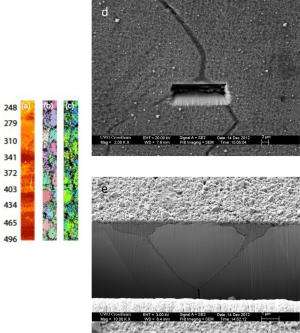X-ray diffraction technique 'maps' strain and crack propagation in metallic tubing

A team of researchers exploring the intergranular stress corrosion cracking of a type of metallic tubing used within nuclear power plants has developed a technique to both map and predict its propagation.
Metallic tubing plays a key role in transporting water coolant to steam generators within nuclear power plants. But for reasons that remain elusive, in this application, Alloy 600, a high-strength nickel-based alloy widely used and considered robust in other high-performance situations, is susceptible to costly failure caused by intergranular stress corrosion cracking.
A team of researchers delved into this longstanding technical issue by using an x-ray diffraction technique to measure structural changes within microscopic areas on the metallic tubing, which they describe in a paper in Corrosion journal.
"Failures of Alloy 600 are preceded by mechanical strains, but the location of this type of strain is often a tiny area only a few microns wide, which has been mechanically damaged by a physical process like a micro scratch or a chemical process such as rapid local corrosion," explains Stewart McIntyre, co-author of the paper and an emeritus professor in the Department of Chemistry at the University of Western Ontario in London, Canada.
It's important to "identify the very tiny areas on samples that are under local tensile stresses—because these stresses can pull a material apart at the boundary between two metal grains," McIntyre says.
To zero in on these areas under local tensile stresses, McIntyre and colleagues turned to a very small and coherent x-ray beam of the sort produced in synchrotrons, such as the Advanced Light Source at Lawrence Berkeley National Laboratory.
"With such facilities we can 'map' the location of strains to determine whether their direction is likely to result in crack propagation in the future," says McIntyre.
Next up? The researchers plan to study the effects of external stresses of different magnitudes imposed on boiler tubing made from Alloy 600, as well as its new replacement, Alloy 690.
More information: The paper, "Mapping of Microscopic Strain Distributions in an Alloy 600 C-Ring After Application of Hoop Stresses and Stress Corrosion Cracking," written by N.S. McIntyre, J. Ulagnathan, T. Simpson, J. Qin, N. Sherry, M. Bauer, A.G. Carcea, R.C. Newman, M. Kunz, and N. Tamura, appears in NACE International's journal, Corrosion, Jan. 2014, Vol. 70, No. 1, pp. 66-73. See: dx.doi.org/10.5006/1006
Provided by NACE International



















